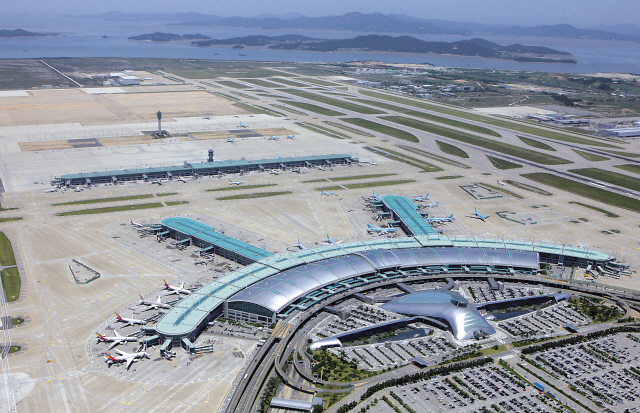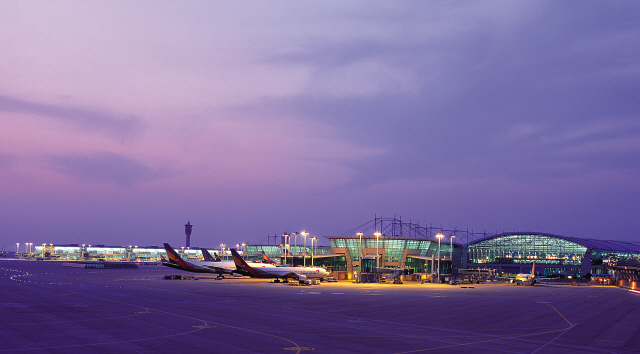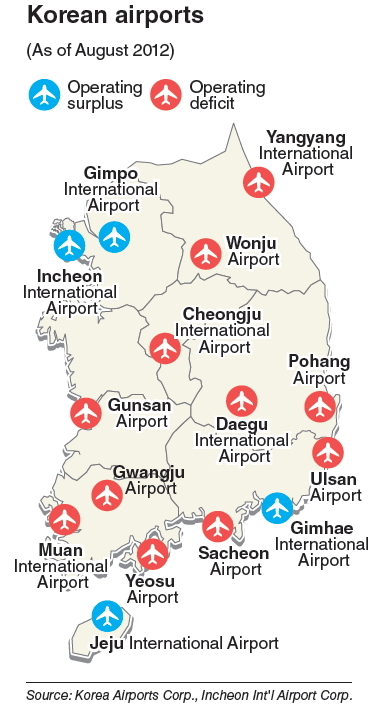[Power Korea] Korea aims to export airport infrastructure
By Korea HeraldPublished : June 17, 2013 - 20:09

Hope that a Korean consortium, led by the Incheon International Airport Corp., could win the first deal to build an international airport overseas this month is rising as the government is developing a package of programs to support the deal.
Backed up by its global brand power, the IIAC partially exported its know-how to Russia, the Philippines, Nepal, Cambodia and Indonesia, but has not yet exported a full package deal, which includes construction of an airport, terminals and operational system.
The consortium is bidding for a project to build the new Hanthawaddy International Airport in Yangon, the former capital city of Myanmar, with a group of international bidders. The announcement of the final winner is expected to come by the end of this month.
As part of last-minute efforts to win the project, a high-level Korean delegation led by Deputy Prime Minister and Finance Minister Hyun Oh-seok will visit Naypyitaw, the capital city of the resource-rich Southeast Asian country, on Wednesday and discuss bilateral economic cooperation on a comprehensive level.
Government sources confirmed one of the key agenda of the talks would be cooperation for developing the air transport infrastructure of Myanmar, which could handle 10 million passengers a year.
The state-run Export-Import Bank of Korea has hinted that it would finance the project if the Korean consortium wins the deal.
Backed up by its global brand power, the IIAC partially exported its know-how to Russia, the Philippines, Nepal, Cambodia and Indonesia, but has not yet exported a full package deal, which includes construction of an airport, terminals and operational system.
The consortium is bidding for a project to build the new Hanthawaddy International Airport in Yangon, the former capital city of Myanmar, with a group of international bidders. The announcement of the final winner is expected to come by the end of this month.
As part of last-minute efforts to win the project, a high-level Korean delegation led by Deputy Prime Minister and Finance Minister Hyun Oh-seok will visit Naypyitaw, the capital city of the resource-rich Southeast Asian country, on Wednesday and discuss bilateral economic cooperation on a comprehensive level.
Government sources confirmed one of the key agenda of the talks would be cooperation for developing the air transport infrastructure of Myanmar, which could handle 10 million passengers a year.
The state-run Export-Import Bank of Korea has hinted that it would finance the project if the Korean consortium wins the deal.

History of airport infrastructure development
Competitive airport development has become a key national agenda ahead as international transactions, both people and cargo, have been increasing fast in an era of globalization. For emerging nations Incheon International Airport, opened in 2001, is a benchmark.
The history of Korean airports started when the Japanese army built a landing strip at the site of the current Gimpo International Airport in Seoul in 1939. After independence from Japan in 1945, commercial airplanes were allowed to land at the airport.
In 1958, Gimpo airport was renamed as Gimpo International Airport and its full-scale upgrade into an international airport was completed in 1971.
In the 1980s, local demand for aviation skyrocketed, affected by the 1988 Seoul Olympic Games and liberalization of overseas travel in 1989. Gimpo International Airport reached its capacity. With the limit in expansion of Gimpo airport due to noise suffered by residents of the surrounding areas, the government established the “New International Airport Construction Working Group” in March 1989 to discuss issues regarding new international airports beyond Gimpo, including sites and regulations. The group established new airport development policies for Seoul, Busan, the eastern coastal areas, western coastal areas and Jejudo Island and the policy planning led to opening of several international airports ― Incheon International Airport in 2001, Yangyang International Airport in Gangwon Province in 2002 and Muan International Airport in South Jeolla Province in 2007.
As of 2013, Korea has nine international airports: Incheon, Gimpo, Gimhae, Jeju, Cheongju (in North Chungcheong Province), Daegu, Yangyang, Gwangju and Muan. It has also six domestic airports nationwide.

Airport development and operation
In the history of Korea’s aviation development, the government has taken the helm for planning and construction of airports since the establishment of the aviation department under the Bureau of transport, the Ministry of Traffic in 1948.
Korea Airports Corp. and the IIAC, both of which are under the ministry, are responsible for airport operations and management.
KAC is in charge of the airports in Gimpo, Jeju, Yangyang, Muan, Ulsan and Yeosu, South Jeolla Province, which are purely civilian airports. KAC also jointly operates the airports in Gimhae, Daegu, Gwangju, Cheongju, Sacheon, South Gyeongsang Province and Wonju, Gangwon Province with the Korean Air Force; Pohang, North Gyeongsang Province, with the Navy; and Gunsan, North Jeolla Province, with the U.S. Air Force.
Incheon Airport is managed and operated solely by the IIAC, in accordance with the Act on Incheon International Airport, passed in 1999.
Financially faltering local airports
In contrast to four international airports ― in Incheon, Jeju, Gimpo, and Gimhae ― other airports in Korea are facing financial losses due to poor demand. The global economic downturn and continued expansion of highways and express railroads have decreased demand for local aviation.
Some airports tried to cut their deficits by reducing or abolishing loss-making routes, but some airports have closed.
Industry experts advise that airports need to reinforce their promotional activities to attract tourists with more attractive tour products tailored to each region, so as to attract or create domestic and international aviation demand. In addition, they recommend local governments consider airport fee discounts and financial support for airlines.
By Seo Jee-yeon (jyseo@heraldcorp.com)
-
Articles by Korea Herald



![[Herald Interview] 'Amid aging population, Korea to invite more young professionals from overseas'](http://res.heraldm.com/phpwas/restmb_idxmake.php?idx=644&simg=/content/image/2024/04/24/20240424050844_0.jpg&u=20240424200058)













![[KH Explains] Korean shipbuilding stocks rally: Real growth or bubble?](http://res.heraldm.com/phpwas/restmb_idxmake.php?idx=652&simg=/content/image/2024/04/25/20240425050656_0.jpg&u=)

